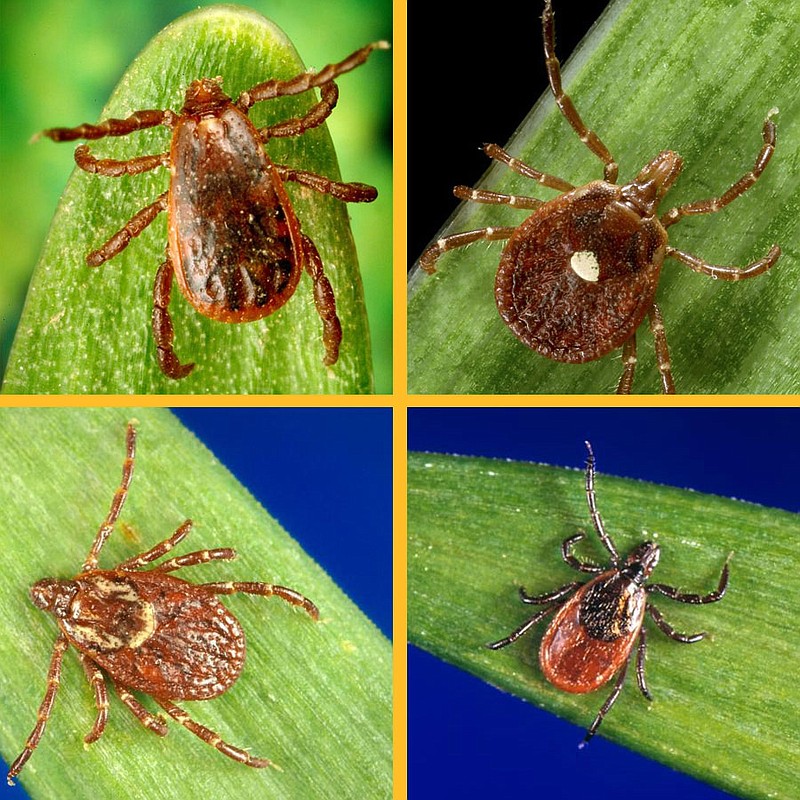It's tick season.
The ticks don't know that. They are active year-round. They just have more opportunities in summer to attach themselves to human hosts.
And as the season progresses, the number of cases of tick-borne illnesses is increasing.
Jaime Young, Cole County communicable disease and epidemiology coordinator, said reports of possible tick-related illnesses began to stream into the agency in May. Investigations into the cases led officials to determine Cole County had six confirmed cases of Rocky Mountain spotted fever and one case of ehrlichiosis caused by a tick bite during the month.
Ehrlichiosis - transmitted to humans by the lone star tick, according to the U.S. Centers for Disease Control and Prevention - usually causes fever, headache, fatigue and muscle aches and can be fatal if not properly treated.
Rocky Mountain spotted fever - transmitted to humans by the American dog tick, brown dog tick and Rocky Mountain wood tick - causes fever, headache, rash, nausea, vomiting, muscle pain and lack of appetite. Almost all patients who come down with Rocky Mountain spotted fever develop a rash in two to four days after a fever begins. Although the condition does not result in chronic or persistent infections, in severe cases it can cause damage to blood vessels which leads to amputations of fingers, toes, arms or legs, according to the CDC.
So far, this year's tick season reflects 2017.
"Through the end of May, it looks very much like it did last year," Young said. "Virtually identical."
In May 2017, there were six confirmed cases of Rocky Mountain spotted fever in Cole County. There were no cases of ehrlichiosis, she said.
"I'm getting pretty flooded with (reports)," Young said. "I do think my June numbers are going to be quite a few more."
Often through her investigation, Young finds the reported cases don't meet CDC criteria to be confirmed cases.
Halfway through May, Missouri already had 37 confirmed cases of Rocky Mountain spotted fever and 14 cases of ehrlichiosis, according to the state Department of Health and Senior Services. The CDC reported diseases transmitted from ticks tripled from 2004-16. Since 2004, nine new diseases spread by mosquitoes and ticks were discovered in the United States.
A possible case of Bourbon virus was reported in St. Louis County in May. Bourbon virus is a rare infection identified in a small number of patients in the Midwest and South. Because it is so rare, scientists are still identifying its symptoms. People diagnosed with the disease had fever, tiredness, rash, headache, other body aches, nausea and vomiting.
Initial testing on the St. Louis County case were negative, but further testing indicated a possible positive result. More testing, requiring blood samples to be collected over time, is necessary.
All the diseases have something in common - the tick bite.
Avoiding ticks is the easiest way to avoid the tick-borne illnesses.
The CDC recommends these precautions:
Use an insect repellent with a minimum of 20 percent DEET, picaridin or IR3535 on exposed skin and clothing. Choose a product that lasts several hours whenever you spend time outdoors. DEET products should not be used on infants under 2 months old.
If you are using sunscreen, apply the sunscreen first and let it dry. Then apply the repellent. Products that contain both sunscreen and repellent are not recommended.
When possible, wear protective, light-colored clothing to keep ticks off skin. The light color allows you to more easily see ticks on your clothes. Also, you should wear long-sleeve shirts and pants. Tuck the pants into your boots when hiking.
Always check yourself, family or friends for ticks after spending time outdoors. Change your clothing and shower quickly after spending time outdoors when possible.
If you find a tick attached to your skin, remove it as soon as possible. Tweezers work best. Grasp the tick as close to the skin surface as possible. Pull upward with a steady, even pressure. If the mouth parts break off inside the skin, try to remove them with the tweezers. If that is unsuccessful, leave the bite alone and let the skin heal over it. After removing the tick, clean the bite with soap and water. If you develop a rash or fever within several weeks of removing the tick, see your doctor and tell them about the bite.
Pet owners should talk to their veterinarians about what tick-borne illnesses are in the area and the best ways to prevent ticks from biting their pets. They should check their pets daily for ticks and just like humans, if you find a tick, remove it right away.
Even the smallest seed ticks can transmit illnesses to humans, Young said.
"If somebody is having flu-like symptoms in the summer - fever, body aches, headaches - those are pretty common indications of tick-borne illnesses," she said. "They should see a doctor."

